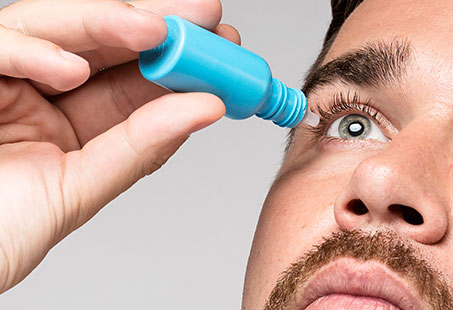Droopy upper eyelids can make you look sleepy, tired, sad, and angry. They can also compromise your vision. It has been common practice to treat this problem with blepharoplasty, but a non-surgical solution is now available as well.
It’s sold under the brand name Upneeq as eye drops. And although it is considered an alternative to traditional eyelid surgery, the results can be quite different. Additionally, not everyone is a good candidate for these eye drops.
What Is Upneeq?
Upneeq is an FDA-approved treatment for acquired ptosis of the upper eyelids. It contains an alpha-adrenergic agonist (α-agonist) – oxymetazoline. It works by binding to the α- receptors on the muscles, resulting in their contraction. This, in turn, lifts the eyelids.
Upneeq is a prescription medicine that needs to be used once daily, and its results are not permanent. According to clinical trials, it can last for as long as 6 hours and may start working in about 2 hours (some even saw the result 5 minutes after usage).
If you wear contact lenses, you need to take them off 15 minutes before you put in the eye drops. And if you’re using any other eye drops, you need to wait for 15 minutes before you use them.
Before considering using these eye drops, keep in mind that they’re prescribed for acquired ptosis of the eyes only. You cannot use it to correct your droopiness if you are born with it.
What Is Acquired Blepharoptosis?
Here, it should be noted that Upneeq works on acquired blepharoptosis. The most common cause of it is ageing, which stretches the levator palpebrae superioris muscle in the upper eyelid. This muscle is responsible for holding the position of the upper eyelid. It is also possible for contact lenses, eye surgery, and physical trauma to cause premature droopiness of the eyelids. Acquired ptosis can also be caused by the following illnesses:
- Myasthenia gravis
- Horner syndrome
- Diabetes
- Multiple sclerosis
- Tumour
- Stroke
- Aneurysm
- Eye infection
- Mitochondrial diseases
- Congenital myopathies
- Muscular dystrophy
- Eye muscle weakness
- Neurological disorders
Temporary ptosis of the upper eyelids can also occur if the Botox is injected incorrectly. The botulinum toxin will paralyse and relax the muscle in the upper eyelids, which can cause droopiness. Other than that, you should also know that the degree of droopiness can vary. It is mild when the upper eyelids droop by 1-2 mm or quite severe when it hangs by more than 4 mm.
What Are The Risks & Side Effects of Using Upneeq?
Using upneeq can cause the following side effects:
- Eye inflammation
- Blurred vision
- Dry eyes
- Headache
- Eye irritation
- Pain in the eyes
One of the most unpleasant side effects of upneeq is known as rebound redness, which causes redness in the eyes. It is a condition in which the blood vessels in the eyes remain dilated even after the effects of the medicine wear off. Long-term use of these eye drops can cause this problem.
Other than that, Upneeq may increase the risk of glaucoma (damage to the nerve connecting the eyes to the brain). You should keep an eye out for the symptoms of glaucoma. The company itself warns about the risk of increased pressure in the eyes as a result of using these eye drops in patients who have untreated narrow-angle glaucoma.
Lastly, it’s not so much of a risk, but you should make sure that the tip of Upneeq’s vial doesn’t touch your eyes. It can cause injury or result in contamination. The single-use vials should be discarded immediately, anyway.
What Are The Contraindications For Upneeq?
The use of upneeq is contraindicated in the following situations:
- Blood Pressure: Upneeq can cause increased blood pressure and heart rate. Therefore, if you have blood pressure or another cardiac problem, you may not be given this treatment for droopy eyelids. The same may be the case if you’re taking beta-blockers.
- Poor Blood Circulation: These eye drops can cause worsening of the problems related to blood flow. Those with Sjögren’s syndrome (a condition that causes dry eyes and mouth) may not be able to use it.
- Absorption Of Antidepressants: Upneeq can interfere with how the body absorbs certain antidepressants, so you may be advised another treatment.
- Overdose: If you’re taking other drugs that contain the same ingredients as Upneeq, there’s a risk of overdose. You should know that nasal sprays have the same active ingredient as Upneeq, so you might be advised against using them when you’re using nasal sprays.
Make sure to consult your doctor before using Upneeq if you’re pregnant or breastfeeding. Ask about all the potential pros and cons of this drug. You may be prescribed this if you really need it.
Upneeq vs. Blepharoplasty: What’s The Difference?
Both Upneeq and blepharoplasty can lift the upper eyelids. However, there are differences in the kind of results that you can achieve from these treatments. Moreover, each of these treatment options is more suitable in certain instances.
Results
Upneeq will lift your upper eyelids by 1 mm. This can be helpful if you have mild ptosis. However, as mentioned above, the skin of the upper eyelid can hang by more than 4 mm, and it can significantly obstruct the field of vision. In that case, upneeq will not yield satisfactory results.
Also, if you have excess skin and fat around the eyes, the weight of it will cause droopiness and upneeq will not address the source of the problem. A blepharoplasty, on the other hand, is more suitable for you if you have moderate to severe eyelid ptosis. It will remove excess skin, reposition the fat pads and tighten the muscles underneath the skin, which can give you dramatic results.
Longevity
As far as the longevity of the results is concerned, Upneeq doesn’t last for more than 6 hours. You have to continue using it to see results, and that can cause adverse effects. An eyelid surgery, on the other hand, will give you permanent results. Although your skin will still continue to change as a result of ageing and gravity, you won’t experience significant problems.
Type of Ptosis
As mentioned before, Upneeq is approved for the treatment of acquired ptosis. It cannot treat congenital ptosis, which can be present at birth or develop within the year following birth. Keep in mind that Upneeq is only approved for adults. It cannot be used on children younger than 13.
It is possible to treat congenital and acquired ptosis with blepharoplasty. Although challenging, blepharoplasty has also been performed on children for the treatment of congenital droopiness of the eyelids.
Cost
A 30-day supply of Upneeq can cost you more than $210 (~180 GBP). The price can vary depending on the pharmacy. Additionally, you may be able to avail of a discount if you get a 90-day supply instead of 30-days. The price may also be lowered if you have medical insurance.
Still, keep in mind that you have to continue using Upneeq to see results, and you have to use it once daily. A yearly supply of this drug can end up costing you more than $2,520 (~2,175 GBP). In contrast, according to the NHS, an eyelid surgery should cost you anywhere between £2,000 and £6,000; Medical insurance can cover it if it’s causing significant obstruction of the field of vision. In Turkey, it would cost you anywhere around £1,500. And since it’s a one-time procedure, you’ll only be paying for it once.
Is Upneeq Better For You Compared To Blepharoplasty?
It depends on how heavily your eyelids are drooping. If the problem is not so severe, you can consider using Upneeq. However, make sure to consult your doctor. Upneeq can have some side effects, and it is contraindicated in some situations.
If, however, your eyelid ptosis is a result of excess sagging of the skin, loss of muscle tone and fat pads in the upper eyelids, you may better benefit from eyelid surgery. Keep in mind that Upneeq is not a non-surgical alternative to eyelid surgery. They both work very differently, and their results are also quite different.
There are also other surgical treatments that can help lift the upper eyelids. These include brow lifts or facelifts. You should consult your doctor about the best route of treatment depending on the extent of your problems and your needs and expectations.
Concluding Remarks
Upneeq is a non-surgical solution for the treatment of eyelid ptosis that has been acquired due to one reason or another. It can help lift the eyelids by 1 mm, so it can be helpful in mild cases. However, keep in mind that the use of these eye drops can cause some adverse effects, rebound redness being quite problematic. Also, its effect lasts for no more than 6 hours. You have to use it once daily.
Keep in mind that if you have droopy eyelids due to excess skin and fat, you can get much better results with a blepharoplasty. Also, if the eyelids are drooping moderately or severely, eyelid surgery can dramatically change the position of your upper eyelids. It works for both acquired and congenital ptosis. Undergoing an eyelid surgery will also cost you much less than Upneeq in the long run. In any case, make sure to consult your doctor so that you can make an informed decision.

